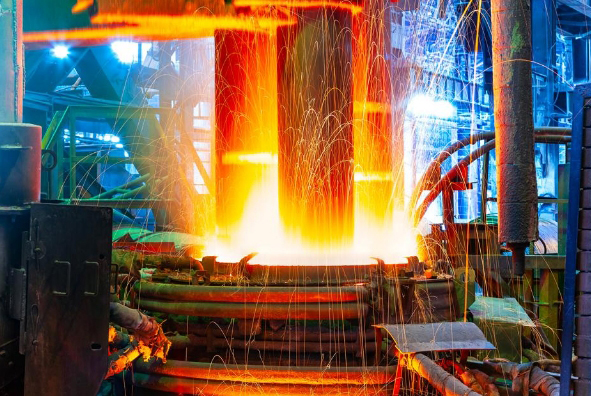
Calcium treatment has become a widely used steelmaking technology. One of its earliest applications involved avoiding nozzle clogging in continuous casting; calcium complexes manganese sulfides into solid Ca,MnS inclusions that do not deform to elongated stringers and thus do not negatively impact through-thickness ductility and toughness.
Most BOF steel plants use high-calcium quicklime; however, dolomitic lime has been shown to extend refractory life.
Cored wires are manufactured by encapsulating powdered metals, ferroalloys and minerals into thin steel sheaths which are then coiled. This allows them to be injected into molten steel at high speed and with great accuracy. It also eliminates the problems caused by attempting to add these ingredients as a lump in the ladle, such as low recovery and oxidation of additives.
In order to maximize the efficiency of cored wire injection it is critical that the iron powder used in these products meets a range of strict criteria including consistent grain size distribution, low powder density and good flow characteristics during form and fill. Hoganas’ specially designed iron powders meet these requirements while also improving spatter levels, arc stability, slag detachability and bead shape.
A successful cored wire process is dependent on the accurate estimation of the melting time of the sheath (casing). To address this issue, we have developed a multi-disciplinary project that combines fluid-dynamics and thermodynamics calculation codes to study the diffusion and transport of calcium from the casing into the liquid steel.

Slag foaming increases the contact area between the steel, slag, and gas phase accelerating oxygen transfer and physicochemical reaction between the two. It also controls the shape of non-metallic inclusions during hot rolling, which enables better isotropic properties for the material.
Physical modeling has shown that slag foaming is dependent on several factors including superficial gas velocity, dynamic viscosity, and surface tension. The slag basicity, bath temperature, slag density, and bubble size also influence the foaming index (FI).
Carbon is used to initiate the foaming reaction as it reduces the slag melting point by combining with slag components to produce CO gas, thereby increasing the slag foaming rate. The presence of large carbonaceous particles decreases slag foaming while fine carbonaceous and CaO powder improves it. The slag foaming behavior has been evaluated using Mossbauer spectroscopy with different carbon sources. The IS and QS values indicate that the foaming indices increase with the amount of fixed carbon in the carbon source.
Slag is the active ingredient of most metallurgical processes. It provides the essential functions of steel-making but its expansive nature makes it difficult to use as construction material. There is general agreement in the technical literature that unslaked lime and magnesia hydrate when they come into contact with moisture, and this causes the rapid volume changes in the slag which can be so troublesome to construction sites.
Ca treatment prevents this in several ways. Firstly it lowers the sulfide content of the steel to a level which does not affect the quality of the final product (S can be brought down to 0.005 % in routine practice). Secondly, calcium treatment changes the composition and shape of inclusions in aluminum killed steel. It converts inter-dendritic alumina inclusions into fine Type III inclusions, which do not clog continuous caster nozzles, and it complexes manganese sulfides so that they do not deform to elongated stringers and thus adversely affect through-thickness ductility and toughness.
Modern metallurgical ladles are capable of performing many different tasks such as deoxidation, desulfurization, controlled additions of alloying elements, inclusion modification and slag treatment. These operations are typically carried out by pushing thin, hollow wires filled with the necessary addition into the liquid steel. The additions are then pushed along the bottom of the vessel where they are dispersed into the slag and liquid steel. Argon or electromagnetic stirring are then used to ensure that the temperature of the slag and liquid steel is homogenized throughout the ladle.
A multiphase modeling approach has been developed to investigate the impact of gas injection on the thermal field in a liquid steel bath. It combines an Eulerian-Eulerian two-fluid model with location-based particle tracking. The model predicts that the injection point does not cause any major displacement of the injected particles and their distribution. In addition, it predicts that the injected particles will spread outward and trail downwards until they reach a critical time (tc) where they begin to dissolve into the molten steel.

Write a Message